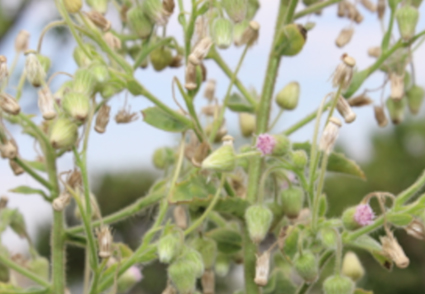Abstract
Blumea is one of the largest genus within the tribe Inuleae, Asteraceae, with approximately 100 species across tropical Asia, Africa, Oceania, and the Americas. It is characterized by disciform capitula, one large oxalate crystal in each cypsela epidermis cell, radial anther endothecium thickenings, and tailed anthers. There are no native species of Blumea in the Americas and Hawaii. However, two species have been documented, and both were introduced. Thus, this work documents the first records of Blumea axillaris in the Americas and the first report of this genus in Brazil. We provided a morphological description of the species, with ecological observations, a key for identifying the Blumea among the genera of the tribe Inuleae found in Brazil, and illustrations. This record serves as a warning since it is an invasive exotic species that, by all indications, has already firmly established itself as a weed and can represent significant challenges for agriculture and the environment.
References
- Anderberg, A.A. (2009) Inuleae. In: Funk, V.A., Susanna, A., Stuessy, T.F. & Bayer, R.J. (Eds.) Systematics, evolution, and biogeography of Compositae. IAPT, Vienna, pp. 667–680.
- Anderberg, A.A. & Eldeñas, P. (2007) XVII Tribe Inuleae Cass. (1819). In: Kadereit, J.W., Jeffrey, C. (Vol. Eds.) & Kubitzki, K. (Series Ed.) Flowering Plants. Eudicots. Asterales, The families and genera of vascular plant. vol. 8. Springer. Berlin, Heidelberg, New York, pp. 374–391.
- Badillo, V.M. (1974) Blumea viscosa y Piptocarpha cuatrecasiana, dos nuevas combinaciones en Compositae. Revista de la Facultad de Agronomia 8: 9–16.
- Beentje, H. (2016) The Kew plant glossary: an illustrated dictionary of plant terms. (2nd edition). Kew Publishing, Richmond, Surrey, 184 pp. https://doi.org/10.1614/WS-06-161
- Candolle, A.P. de (1833) Generes nouveaux appartenant à la famille des Composées ou Synanthéeres. In: Guillemin, J.B.A. (Ed.) Archives de Botanique, vol. 2. Au bureau des archives, Paris, pp. 514–519.
- Candolle, A.P. de (1836) Prodromus Systematis Naturalis Regni Vegetabilis, vol. 5. Treutel & Würtz, Paris, 706 pp.
- Davies, K.W. & Sheley, R.L. (2007) A conceptual framework for preventing the spatial dispersal of invasive plants. Weed Science 55: 178–184.
- eFloras (2008) eFloras.org. Missouri Botanical Garden, St. Louis, MO & Harvard University Herbaria, Cambridge, MA. Available from: http://www.efloras.org (accessed 11 March 2024)
- Fayed, A. & Mohamed, M. (1991) Systematic revision of Compositae in Egypt. 6. Tribe Inuleae: Inula and related genera. Willdenovia 20: 91–96.
- IPNI. (2024) The International Plant Names Index. Available from: http://www.ipni.org (accessed 11 March 2024)
- Lamarck, J.B.A.P.M. de (1786) Encyclopédie Méthodique. Botanique, vol. 2, part 1. Chez Panckoucke, Paris, 400 pp.
- Lessing, C.F. (1832) Synopsis generum Compositarum, earumque dispositionis novae tentamen monographus multarum capensium interjectis. Duncker & Humblot, Berlin, 473 pp. https://doi.org/10.5962/bhl.title.51470
- Loureiro, J. (1790) Flora Cochinchinensis, vol. 2. Ulyssipone, Typis, et expensis academicis, Lisbon, 744 pp.
- Merrill, E.D. (1935) Loureiro’s Flora Cochinchinensis. Transactions of the American Philosophical Society Held at Philadelphia for Promoting useful Knowledge 24: 387–388. https://doi.org/10.2307/1005470
- Miller, P. (1768) The gardeners dictionary: containing the best and newest methods of cultivating and improving the kitchen, fruit, flower garden, and nursery, as also for performing the practical parts of agriculture, including the management of vineyards, with the methods of making and preserving wine, according to the present practice of the most skilful vignerons in the several wine countries in Europe, together with directions for propagating and improving, from real practice and experience, all sorts of timber trees, vol. 1. (8th edition). Rivington, London, 443 pp. https://doi.org/10.5962/bhl.title.541
- MNHN (2024) Museum national d’Histoire naturelle. Available from: http://science.mnhn.fr/institution/mnhn/collection/p/item/search/form (accessed 11 March 2024)
- Monge, M., Anderberg, A.A. & Semir, J. (2017) Tribo Inuleae Cass. In: Roque, N., Teles, A.M. & Nakajima, J.N. (Eds.) A família Asteraceae no Brasil: classificação e diversidade. EDUFBA, Salvador, pp. 153–160. https://doi.org/10.7476/9788523219994.0022
- Monge, M. & Semir, J. (in memorian) (2024) Inuleae. In: Flora e Funga do Brasil. Jardim Botânico do Rio de Janeiro. Available from: https://floradobrasil.jbrj.gov.br/FB101568 (accessed 11 March 2024)
- Mori, S.A, Berkov, A., Gracie, C.A. & Hecklau, E.F. (2011) Tropical plant collecting: from the field to the internet. TECC, Florianópolis, 332 pp.
- Nesom, G.L. (1983) The evolutionary origin of Blumea viscosa (Asteraceae) and a first report from North America. SIDA, Contributions to Botany 10: 30–32.
- Peng, Y., Yang, C. & Luo, Y. (2020) Blumea htamanthii (Asteraceae), a new species from Myanmar. PhytoKeys 138: 225–232. https://doi. org/10.3897/phytokeys.138.38815
- Pornpongrungrueng, P., Borchsenius, F., Englund, M., Anderberg, A.A. & Gustafsson, M.H.G. (2007) Phylogenetic relationships in Blumea (Asteraceae: Inuleae) as evidenced by molecular and morphological data. Plant Systematics and Evolution 269: 223–243. https://doi. org/10.1007/s00606-007-0581-7
- Pornpongrungrueng, P., Borchsenius, F. & Gustafsson, M.H.G. (2009) Relationships within Blumea (Inuleae, Asteraceae) and the utility of the 5S-NTS in species-level phylogeny reconstruction. Taxon 58: 1181–1193. https://doi.org/10.1002/tax.584011
- Pornpongrungrueng, P., Gustafsson, M.H.G., Borchsenius, F., Koyama, H. & Chantaranothai, P. (2016) Blumea (Compositae: Inuleae) in continental Southeast Asia. Kew Bulletin 71: 1–46. https://doi.org/10.1007/s12225-016-9612-2
- Randeria, A.J. (1960) The Compositae genus Blumea: a taxonomic revision. Blumea 10: 176–317.
- Roque, N. & Bautista, H. (2008) Asteraceae: caracterização e morfologia floral. EDUFBA, Salvador, 71 pp.
- Thiers, B.M. (2024 onwards) Index Herbariorum: a global directory of public herbaria and associated staff. New York Botanical Garden’s Virtual Herbarium. Available from: http://sweetgum.nybg.org/science/ih/ (accessed: 11 March 2024)


